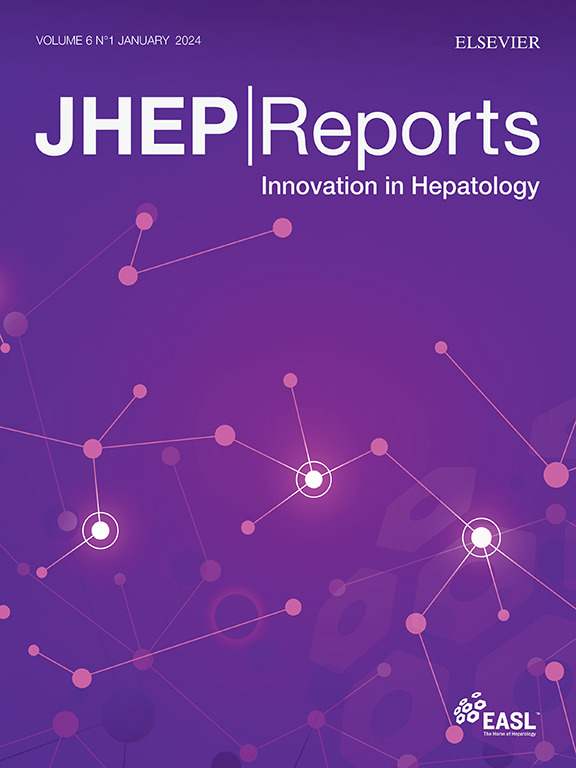使用替诺福韦阿拉非酰胺可降低慢性乙型肝炎患者肝细胞癌的发病率:来自大规模队列的证据。
IF 9.5
1区 医学
Q1 GASTROENTEROLOGY & HEPATOLOGY
引用次数: 0
摘要
背景与目的:替诺福韦(TAF)对肝细胞癌(HCC)的影响缺乏广泛的研究。本研究利用全国索赔数据评估并比较了TAF、富马酸替诺福韦二吡酯(TDF)和恩替卡韦(ETV)对HCC发病率的影响。方法:共纳入75,816例treatment-naïve HBV患者,排除后分为TAF组(n = 25,680)、TDF组(n = 26,954)和ETV组(n = 23,182)。倾向评分匹配(1:1:1)结果每组17537例患者。比较两组间HCC发生率。结果:配对前,TAF组的HCC发生率明显低于TDF和ETV组(11.47 vs 15.04和14.24 / 1000人年)。TDF的发病率比(IRR)为1.31 (1.19-1.44),ETV的发病率比为1.24(1.12-1.37)。配对前,无论有无肝硬化,TAF组的HCC发生率均明显低于TDF和ETV组。配对后,TAF组HCC发生率低于TDF组(12.38 vs. 15.39, IRR 1.24, p p = 0.219)。在肝硬化患者中,与TDF和ETV相比,TAF的HCC发生率较低(分别为30.25比39.56和38.51)。在无肝硬化的患者中,TAF组的HCC发生率低于TDF组(IRR 1.19, p = 0.030),而ETV组的发生率低于TAF组(IRR 0.85, p = 0.066)。Cox回归分析显示,在调整年龄、性别和肝硬化状况后,TAF组的HCC发生率明显低于TDF组(风险比1.335,p p = 0.011)。结论:与TDF和ETV组相比,TAF组的HCC发生率始终较低,尤其是在肝硬化患者中。影响和意义:本研究旨在填补关于替诺福韦-丙烯酰胺(TAF)、富马酸替诺福韦-二氧吡酯(TDF)和恩替卡韦(ETV)在降低慢性HBV患者肝细胞癌(HCC)发生率方面的比较疗效的知识空白。这些结果对医疗保健提供者和决策者来说尤其重要,因为它们强调了TAF相关的HCC发病率显著降低,尤其是在肝硬化患者中。这些结果表明TAF是降低HCC风险的首选抗病毒治疗选择,从而影响临床决策和医疗保健指南。从实践的角度来看,这些发现可以指导医生开出更有效的治疗处方,帮助研究人员设计进一步的研究来探索TAF有效性背后的机制,并为政策制定者提供信息,以制定优化患者预后的医疗政策,同时考虑潜在的局限性,如研究的观察性和残留的混杂因素。本文章由计算机程序翻译,如有差异,请以英文原文为准。

Lower incidence of hepatocellular carcinoma with tenofovir alafenamide in chronic hepatitis B: Evidence from a large-scale cohort
Background & Aims
Tenofovir alafenamide (TAF) lacks extensive research regarding its impact on hepatocellular carcinoma (HCC). This study evaluated and compared the effects of TAF, tenofovir disoproxil fumarate (TDF), and entecavir (ETV) on HCC incidence using nationwide claim data.
Methods
In total, 75,816 patients with treatment-naïve HBV were included in the study and divided into TAF (n = 25,680), TDF (n = 26,954), and ETV (n = 23,182) groups after exclusions. Propensity score matching (1:1:1) resulted in 17,537 patients per group. HCC incidence rates were compared among the groups.
Results
Before matching, the incidence of HCC was significantly lower in the TAF group compared with the TDF and ETV groups (11.47 vs. 15.04 and 14.24 per 1,000 person-years). The incidence rate ratio (IRR) for TDF was 1.31 (1.19–1.44) and for ETV was 1.24 (1.12–1.37). Before matching, the TAF group had a significantly lower HCC compared with TDF and ETV in both patients with and without cirrhosis. After matching, the TAF group had a lower HCC incidence compared with the TDF group (12.38 vs. 15.39, IRR 1.24, p <0.001) but not with ETV group (IRR 1.08, p = 0.219). In patients with cirrhosis, TAF had lower HCC incidence compared with TDF and ETV (30.25 vs. 39.56 and 38.51, respectively). In patients without cirrhosis, the TAF group had a lower HCC incidence compared with the TDF group (IRR 1.19, p = 0.030) but not the ETV group (IRR 0.85, p = 0.066). Cox regression analysis showed that the TAF group had a significantly lower HCC incidence compared with the TDF (hazard ratio 1.335, p <0.001) and ETV groups (hazard ratio 1.162, p = 0.011), after adjusting for age, gender, and cirrhosis status.
Conclusions
The TAF group consistently demonstrated a lower incidence of HCC compared with the TDF and ETV groups, especially in patients with cirrhosis.
Impact and implications:
This work aimed to fill the knowledge gap regarding the comparative efficacy of tenofovir alafenamide (TAF), tenofovir disoproxil fumarate (TDF), and entecavir (ETV) in reducing the incidence of hepatocellular carcinoma (HCC) in patients with chronic HBV. The results are particularly crucial for healthcare providers and policymakers, because they highlight the significantly lower incidence of HCC associated with TAF, especially in patients with cirrhosis. These results suggest TAF as a preferable antiviral therapy option to mitigate HCC risk, thus influencing clinical decision-making and healthcare guidelines. From a practical perspective, these findings can guide physicians in prescribing more effective treatments, assist researchers in designing further studies to explore the mechanisms behind the effectiveness of TAF, and inform policymakers to craft healthcare policies that optimize patient outcomes while considering potential limitations, such as the observational nature of the study and residual confounding factors.
求助全文
通过发布文献求助,成功后即可免费获取论文全文。
去求助
来源期刊

JHEP Reports
GASTROENTEROLOGY & HEPATOLOGY-
CiteScore
12.40
自引率
2.40%
发文量
161
审稿时长
36 days
期刊介绍:
JHEP Reports is an open access journal that is affiliated with the European Association for the Study of the Liver (EASL). It serves as a companion journal to the highly respected Journal of Hepatology.
The primary objective of JHEP Reports is to publish original papers and reviews that contribute to the advancement of knowledge in the field of liver diseases. The journal covers a wide range of topics, including basic, translational, and clinical research. It also focuses on global issues in hepatology, with particular emphasis on areas such as clinical trials, novel diagnostics, precision medicine and therapeutics, cancer research, cellular and molecular studies, artificial intelligence, microbiome research, epidemiology, and cutting-edge technologies.
In summary, JHEP Reports is dedicated to promoting scientific discoveries and innovations in liver diseases through the publication of high-quality research papers and reviews covering various aspects of hepatology.
 求助内容:
求助内容: 应助结果提醒方式:
应助结果提醒方式:


